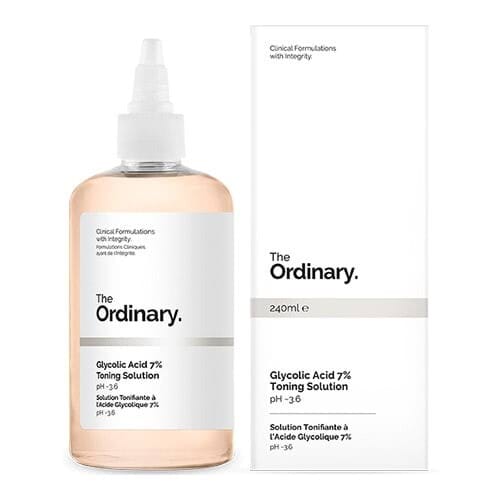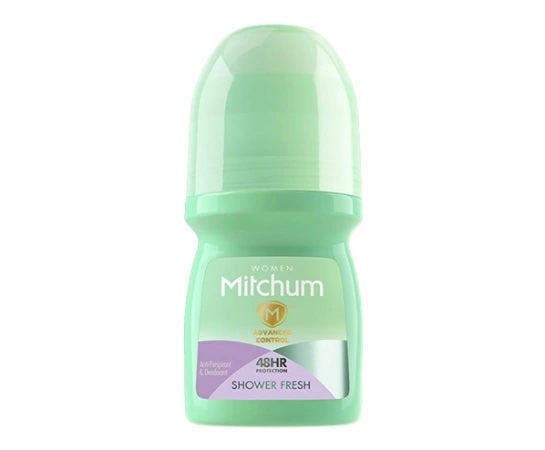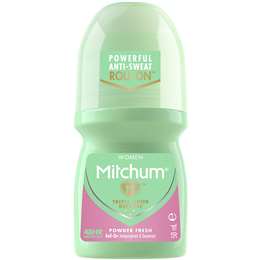Why People On TikTok Are Using Glycolic Acid As Deodorant
At Refinery29 Australia, we’re here to help you navigate this overwhelming world of stuff. All of our picks are independently selected and curated by the editorial team, but we may earn commission or other compensation from the links on this page.
When it comes to beauty hacks, TikTok is an impressive font of knowledge. Some of them are pretty smart (like the viral one-minute messy bun trick and the homemade BB cream) but it's fair to say others are questionable.
This time round, the app's beauty enthusiasts are ditching their deodorant in favour of a swipe of glycolic acid toner under their arms, claiming it stops sweating in its tracks, prevents body odour and minimises pigmentation. The hashtag #glycolicacidasdeodorant has racked up an enormous 4.7 million views as people catch on to the trend, and The Ordinary's Glycolic Acid 7% Toning Solution, $14.50, is the most popular product. But does it actually work? And more importantly, is it safe?
AdvertisementADVERTISEMENT
@wendyskin I put this on a cotton pad and rub it on my armpits everyday! #fyp #tiktokpartner #learnontiktok #skincare #skincarehack #skincaretips
♬ original sound - wendyskin
What is glycolic acid and how does it work?
Whether or not you're a skincare obsessive, you've probably heard skincare experts recommend glycolic acid for use on facial skin as it has multiple benefits. It is recommended to be used at relatively low percentages (such as 5% or 7%) and once or twice weekly as part of an evening skincare routine. "Derived from sugarcane, glycolic acid is a chemical exfoliator, also referred to as an alpha hydroxy acid or AHA," says Dr Ana, aesthetic doctor and skin expert at Kat & Co. "Its small molecular size makes it powerful and enables penetration deep into the skin layers," continues Dr Ana. "It essentially works by breaking the bonds between dead skin cells which helps to resurface (or smooth) the top layer of the skin." Used over time, glycolic acid helps fade pigmentation and can improve rough skin texture. It's why those with skin staining left behind by acne or bumpy, dry skin texture like to incorporate it into their skincare routines.
Glycolic acid is great on paper but there are potential side effects and things you need to know before using it. It's best used at night, after cleansing and before moisturiser, and as it can make skin sensitive to sunlight, it is recommended to wear SPF during the daytime. It pays to be careful, too. "Overuse can lead to over-exfoliation which can break the skin barrier function and lead to irritation (redness, soreness and flaky skin), dehydration (resulting in tight-feeling skin) and breakouts," says Dr Ana.
AdvertisementADVERTISEMENT
Is glycolic acid a good alternative to deodorant?
Judging by the countless TikTok videos, beauty enthusiasts are using glycolic acid as deodorant mainly because they're looking for natural alternatives and rate multipurpose products. According to Dr Priya Verma, medical director at Nova Aesthetic Clinic, glycolic acid is said to "lower the pH of the underarm, creating an inhospitable environment for odour-causing bacteria," which explains why many TikTokers are championing it for reducing body odour. However, Dr Ana says that this is simply a theory and it isn't actually proven to reduce odour. What's more, Dr Verma says there is little evidence that glycolic acid reduces sweating. "In fact, water from sweat will neutralise glycolic acid, reducing any benefits of the acid application," she says.
@skincarebandit S/o to labmuffin for putting me on. Never going back to deodorant #skincarebandit #glycolicacid #deodorant #skincaretips
♬ alors on danse remix - Rachel Giraudo
In other words, any benefits are based on anecdotal evidence. One thing glycolic acid may help improve is underarm pigmentation. Of course, body pigmentation is entirely normal, but it may bother some people. "As glycolic acid exfoliates the skin, it promotes a more rapid cell turnover and reduces the thickening of the skin which leads to underarm hyperpigmentation," explains Dr Verma. "Used correctly, it is effective in reducing unwanted hyperpigmentation," she continues, although Dr Ana adds that there are better options for this purpose in the underarm area.
Is using glycolic acid as deodorant safe?
As glycolic acid can cause irritation on facial skin, it could do the same on underarm skin. "Armpit skin is already sensitive in nature due to constant friction and rubbing, as well as a moist and occluded environment," says Dr Ana, and if you are shaving your skin, this will likely cause further sensitivity, she adds. That slight tingle you feel when applying glycolic acid toner to your face? It could be pretty painful on just-shaven underarms.
AdvertisementADVERTISEMENT
Dr Verma adds that glycolic acid facial toners would be completely unsuitable for use if you’re having a course of laser hair removal in the underarm area. "Glycolic acid isn’t suitable for all, and more sensitive skin types may see an adverse reaction. Overuse of glycolic acid (using it every day) can also lead to over-exfoliation, which compromises the skin’s protective barrier," she continues, causing redness and flakiness. "In the hot and humid environment of the underarm, this would be very undesirable."
While glycolic acid is said to reduce hyperpigmentation when used correctly, if you're using it too often and in high concentrations, it could worsen hyperpigmentation due to causing irritation. "I would prefer to keep the AHA use to the face as this is what your product will have been formulated and intended for," adds Dr Ana.
@jacquelinekilikita Is ##glycolicacid a good deodorant? Here’s what you need to know before trying the ##beautyhack 🧴##theordinary ##glycolicacidasdeodorant
♬ original sound - Jacqueline Kilikita
What happens if you use glycolic acid as deodorant?
Beauty In A Tik is all about putting trends and hacks to the test, so I couldn't resist giving this a go. I was sure to wait a couple of days after shaving to avoid the dreaded sting and decanted a little glycolic acid onto a cotton pad before swiping it underneath my arms, but it still tingled. The initial application felt a little sticky and I can safely say it did nothing to prevent sweating throughout the day. In fact, that stickiness lasted all day, which put me in a bad mood. I decided to test its supposed odour-reducing properties by going on a long walk; unfortunately, it didn't hold up as well as I'd hoped. The smell wasn't as strong as I'd anticipated but I still noticed it at the end of the day and I couldn't wait to jump in the shower.
AdvertisementADVERTISEMENT
I love using The Ordinary's glycolic acid toner on my face (it helps fade marks left behind by spots and smooths bumpy skin texture like no other) but I wouldn't recommend using glycolic acid under your arms — not when there are so many brilliant deodorants out there. Dr Ana seconds this. "I am not a fan of this trend at all and would definitely recommend sticking to tried and tested deodorants (masking odour) or antiperspirants (reducing sweat) formulations with research behind their use. Skincare should be backed by science, not trends."
What is the best deodorant or antiperspirant?
Plenty of TikTok videos warn that aluminium in deodorant is "unsafe" to health but Dr Ana busts this myth. "In contrast to popular belief, there is no hard evidence to suggest that aluminium chloride is actually harmful," she says. Dr Verma adds: "Remember, aluminium-free 'natural' deodorants, containing acids, won’t prevent sweating, they will simply combat odour."
Having tried hundreds of deodorants on the market, nothing beats Mitchum Powder Fresh Anti-Perspirant Roll On, $3.80. It doesn't let a single bead of sweat pass, nixes odour and really does last all day. The Shower Fresh version is just as excellent and is available in an aerosol version if you prefer quick-drying sprays.
AdvertisementADVERTISEMENT
How can you get rid of underarm sweating?
Firstly, sweating is entirely natural. Dr Ana agrees that there are plenty of topical antiperspirants which are effective and far less irritating than glycolic acid but if you still struggle with excessive sweating, she recommends seeing a doctor or dermatologist, who will be able to prescribe treatments to control the bacteria that is creating odour. "Botox is another temporary option for sweating although costly and laborious," says Dr Ana. "I’m a big fan of the miraDry treatment which actually reduces underarm sweat permanently, so my patients end up not needing to even use deodorants after having had this."
The expert consensus is that glycolic acid should be reserved for use on the face rather than underarms. Sorry TikTokers, this hack isn't worth the hype.
AdvertisementADVERTISEMENT










